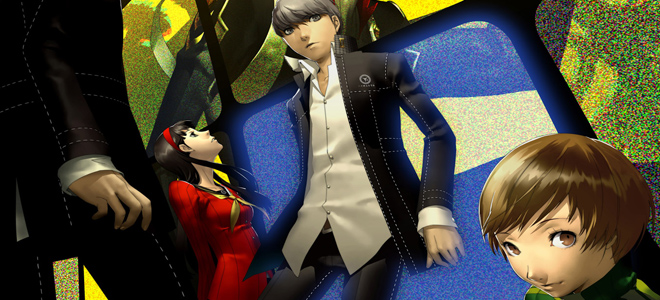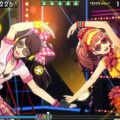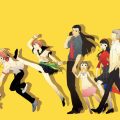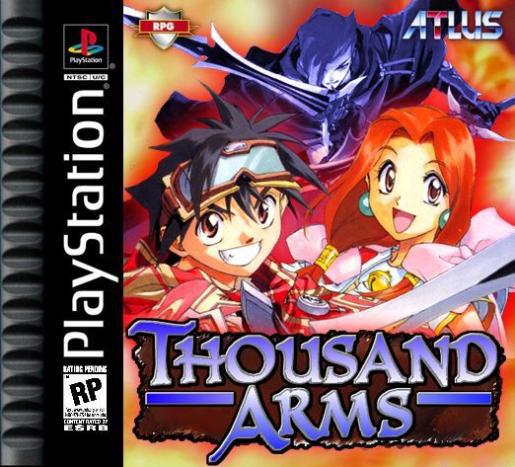Persona 4 Golden reflections
Angela’s had plenty to say on Persona 4 already, and after all these years it’s now my turn to take a crack at it. And I suspect that neither my word nor hers will be the last one here.
I think the reason I plowed through it much faster than Persona 3 FES was because my Vita could go anywhere — which I find the Switch too bulky for. I’m totally a permanently docked guy… which doesn’t bode well for a Steam Dieck, I guess. While I initially considered rebuying the game so I could play it on the big screen, it would seem that would have slowed my progression.
But getting through the game in less time — both in game and out — didn’t result in having less to say about it. This might get a little jargony, as I’m writing it from the perspective of someone who’s at least played Persona 3 rather than starting fresh. After all, that was my perspective while experiencing the game.
Gameplay
It wasn’t as easy as I expected it to be to transition from Persona 3 FES to Persona 4 Golden. There are some aspects of the game that are identical to its predecessor, while other things have been greatly overhauled, with some of the overhauling actually occurring during the upgrade to Golden rather than in the original Persona 4.
It’s certainly very nice that there is a series of small and heavily themed dungeons rather than the endless climb up Tartarus. Having larger dungeon floors are traded off with having fewer total floors. That being said, you’ll still spend a lot of time in the TVland dungeons grinding up quest items, materials to sell to the gear shop and building up money. It’s just a less monotonous and easier to navigate grind.

Changes to combat involve a series of tradeoffs. Here’s a short example: Physical skills lose the nuance between strike, pierce and slash, so several of them became redundant. However, that means you can protect against them with one skill instead of three. Now here’s a long one:
Enemies and allies don’t stay down for a turn when knocked over unless another hit “confirms” the knockdown to cause the new status effect, dizziness. By making it a status effect, both friend and foe alike gain options to prevent it. It also makes it harder to tee up a large group of enemies with differing weaknesses for an all-out-attack because you either have to waste turns double-tapping or have fewer turns to knock them all down before they start getting back up. But to help with this, you can now trigger a 1-more on multi target spells if it hits the weakness of any one enemy instead of the older game’s requirement of all of them. Which applies to the enemies attacks as well, getting really dicey in boss battles. But when you do manage to fire off an all-out-attack, you can end up doing less damage as shadows can now resist or even nullify Almighty-element damage which was previously known for being irresistible. These all-out-attacks are now the only combat method to guarantee a Shuffle Time after the battle, but the mechanics of shuffle time have completely changed allowing you to pick cards directly and focusing on a new meta around selecting multiple cards.
It’s all quite the (game) balancing act, really.
While you don’t have to worry about party members getting tired anymore, returning to the lobby does not grant a full heal. Thus, you will instead be limited in how much dungeon grinding you can accomplish by your ability to conserve or restore SP. Once you’ve met a fox who is also a social link, you can pay for a full recharge of your HP and SP in the lobby of TVland, but it isn’t cheap. I don’t think I ever actually paid for healing from the fox, as by the time its social link discount had become high enough and shadows started dropping more money, my post-battle recovery skills were good enough to not need it. Which is fine, because I desperately needed to save the dough for other things.
That’s because Persona 4 realistically recreates the experience of never having any money as a teenager. Gear starts more expensive than the prior game (though it ends cheaper), and that’s a problem when the game is stingy with money and hardly ever drops weapons and armor in treasure chests. Paid activities also cost more. It “helpfully” provides you with part-time jobs you can take in the evenings that also boost a social stat, but the payout is minimal until you have cranked your stats high enough to get access to better jobs that pay a usable amount of money and progress social links as well. But even with all that, you’ll still always be running out of cash.
While there’s a lot more you can do outside dungeons than in Persona 3, the game also gives you more time to do it and provides multiple methods of boosting social links in-between level up events, raising your social stats and earning money. Nighttime is no longer mostly useless, and spending a Sunday with friends has a much lower opportunity cost than before. That being said, don’t get it in your head that you want to do all everything. These are meant to be options to progress toward a goal; you won’t have time to go to every movie, take every bike trip, do every hangout, read every book, build every model and still expect to complete all the sidequests and social links.

The game is replete with endings, and you’d be forgiven for not counting the first 6 non-standard Game Overs, which simply come from blown deadlines. But the proper endings start coming fast and furious in December, and you have to navigate dialog tree minefields. Chances are you got the first bad ending deliberately. Then you reload and avoid it without realizing the dialog tree has THREE outcomes, and end up getting the second bad ending when you thought you were progressing. A few days later, you come up against another chance to hit two bad endings or progression. You get three chances to choose a suspect from an obnoxiously long list of townspeople. Fail, and it’s Bad Ending No. 3. You have can get Bad Ending No. 4 if you finger the correct suspect and then aren’t decisive about it. But once you’re past that, all you have to do is avoid blowing one last deadline to get one of the three good endings. However, it’s possible to lock yourself out of the best one by not finishing a social link before December ends, the game makes a direct hint as to which one you need to focus on once you’re past the minefields. Though choosing poorly in a single dialog at the start of January will also lock you out. Failing to complete the bonus dungeon when you are specifically told to do so will also lock you out, but screwing up that one’s properly on you. Think you’re done? Heck, no. All that merely decided whether you are eligible for the True or the Golden endings. You have to be on the ball during your literal victory lap on the last playable day of the game or you’ll end up with the Good ending instead, and that choice comes after going through a long process in which the game requires you to say goodbye to all your social links around town, and then refusing to go home when the game asks you, even though going home was telegraphed to be the next thing you were supposed to do. Then you have to go to a particular location you had already been to with all other previously visited locations telling you that you have nothing left to do there. But before this place will let you continue, the game will again prompt you to go home, which you might think had spawned coincidentally. Only after refusing that, too, does the game begrudgingly permit you to complete the story.
That all being said, it’s somehow less annoying than the ridiculous missables in 3D Dot Game Heroes
Themes
I don’t think it would be a stretch to say that Persona 4‘s message was that the path to peace and happiness is through living in the truth rather than hiding from it. The game’s plot presenting itself as a murder mystery establishes a simplified version of the theme, to merely seek the truth that solves the mystery. But the game won’t let you through it without pontificating on the nature of what truth means for humanity or even just a person.
While the final+2 boss in the second secret dungeon on the path to the True+1 Ending makes the plot’s conflict between hiding from the truth and seeking it plainly obvious in dialog, it was present every step of the way. From the fog making the metaphor literal (and showing all those who adapted to its presence — who accepted or even preferred hiding — did so by becoming bastards) to the party being built from people who became stronger and happier when they got a kick in the rear to start presenting themselves to the world without a mask.
While the cast and by extension, the writers, identify the shadows as their “real” selves, even a casual reading makes clear that isn’t the case. It might even be wrong to define them as simply a part of them. While I previously speculated in the #gaming_progress channel on the DC Discord that these shadows were actually the characters’ insecurity, there’s an extra wrinkle to it. The shadow is more specifically what the character fears other people would see in them if they didn’t take action to obfuscate it.

Kanji, for example, isn’t gay like his shadow suggested so much as he
a) Has what are traditionally defined as feminine hobbies due to growing up in the family business; and
b) Keeps obliviously stumbling into double entendres (but that’s why we love him).
His shadow was not a suppressed true self, but rather what he feared others would think of him were he more honest, leading to the dishonest hypermasculine self being his own, personal fog he covers himself with to hide from a world he expects would punish him.
In Persona 4, a person’s shadow is a perception OF a perception. In that sense, shouting “You’re not me!” at them is factually correct, even if the character defined precisely what the shadows represented. But all the characters got the right answer from the wrong equation: when they accept the shadow as part of themselves, they put to rest the fear that others might see them. Despite unintentionally lying to themselves, it leads them to live their lives more authentically from that point onward, and we see the influence that has over the course of their Social Link stories.
The same is true even for those who have not gone through TVland and faced their shadow. Every last one of the other social links involves a person suffering for the lies about themselves they project to others (and those that others project onto them that they refuse to refute), and how they become well-adjusted and, frankly, better by pushing through their anxieties to show the truth instead. As the game tells you every time you form and complete a link, doing so brings you closer to the truth. Not the truth of the crime, but capital-T Truth.
So sure, it’s an RPG where you attack and dethrone (a) god. But it’s not just about averting world destruction. It’s about what humanity is, and how their future should go. The gods of the Persona series seem to be stuck on ending suffering by removing the possibility of suffering like they’re freaking SEELE or something. And our plucky band of heroes du jour have to violently remind the gods that there’s more than one way to treat suffering and they really shouldn’t be throwing the baby out with the bathwater.
Because, at least in Inaba, the reasons people think Truth will cause suffering are simply more lies. And all hiding from the Truth is ever going to do for them is pile the lies on thicker and thicker until they disappear completely into them. And when that happens, all that will be left of them is their shadow, a grotesque fabrication that can only claim to be their true self.
Music
It may seem odd to single this out as a category in general, but the soundtrack is an integral part of the identity of a “modern” Persona game. The music of Persona 4 grew on me over time, but I still think it is the weakest soundtrack of the 3 “modern” Persona games. It often felt like a slightly worse imitation of the Persona 3 soundtrack, down to mimicking its entire structure. Ironically, in a game about people weighed down by expectation and perception discovering and embracing their own identity, the soundtrack was content to do what was expected of it.
Still, there are a few tracks I could recommend, as the saying goes, where 4 actually surpasses its predecessor, or are simply straight-up good in their own right.
“Reach out to the Truth” is a rare example of the motif structure of Persona 4‘s soundtrack actually improving on that of Persona 3. And I suppose on itself, too, as this was a change for Golden. The idea is so simple, yet effective: When you ambush an enemy, you get a brighter-sounding battle theme than “Time to Make History,” a new piece for Golden that replaced “Reach out to the Truth” for all other regular battles. It also has the bonus fun of riffing on “Reach out to the Truth – First Battle” in that sneaking up on an enemy means not only entering the battle early, but also starting that music track at the wrong spot.
Not controlling your party members in Persona 3 was actually less annoying than the fact that on each of the many times the school music changed, it was to something less enjoyable than “Want to be Close”. Persona 4‘s song progression, on the other hand, gets better when it swaps from the fair-weather song “Your Affection” to “Heartbeat, Heartbreak” for the less-sunny days.
“Heaven” is simply the best song in the game. While it’s not nearly the final dungeon, it felt like the culmination of the music for each successive dungeon straying further and further from what came before until we land in what starts like an 80s soft Jazz standard, complete with soprano sax. “Still, music keeps on turning me from the words that hurt my soul,” indeed.






Nice review Geoff! It sounds like you liked it which is good.
I’m not surprised P4 took a while to plow through. I think I might have spend 2 years on and off. Its a fun game, and an experience. Agree that the soundtrack is integral and would consider it overall ‘pretty good’. Hopefully you had a better experience with Golden (I had only played the original), but have no gumption to try for another play-through. Still love the Shin Megami Tensei series in general but social link system is another story
(Drew actually wrote this review, not Geoff.)